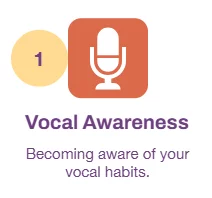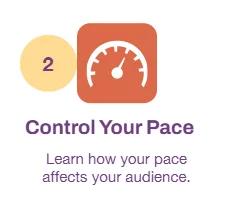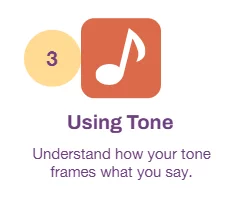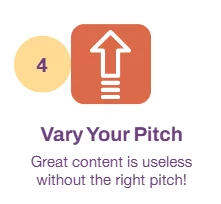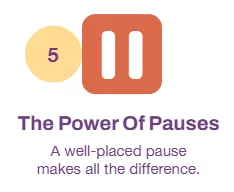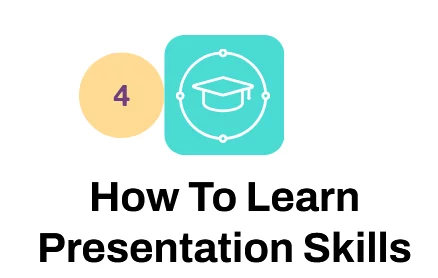
Speak Like A Pro: Mastering Voice, Pace & Tone
Contents
Words matter – but how you say them matters just as much.
A powerful voice can captivate a room with a story, convey confidence, and drive your message home.
Yet, many speakers overlook one of their most versatile tools: vocal delivery.
After years of speaking in high-pressure environments, I’ve learned that voice, pace, and tone can either elevate your presentation or undermine it.
Here’s how to harness these elements to speak like a true professional.
1. Start With Vocal Awareness
Being aware of your vocal habits is the foundation of improvement.
You may discover that you speak more softly than you thought, or that your tone unintentionally sounds flat or stern.
These small revelations can be game-changers.
When you become conscious of your delivery, you gain the power to shape how your message is heard.
This can be adding warmth to foster trust, or boosting clarity to enhance understanding.
Personally, I discovered my natural pace was too fast after hearing myself on playback.
That insight alone changed how I prepare.
Why It Matters:
You can’t improve what you don’t notice.
Great speakers monitor and adjust their voice in real time.
How To Tune In:
-
Record yourself speaking and play it back.
-
Ask for feedback on clarity, variety, and tone.
-
Use vocal warm-ups to connect with your breath and resonance.
2. Control Your Pace
Your pace influences not just comprehension, but emotional engagement.
Think of how a storyteller slows down at a climactic moment, or how a speaker pauses after asking a powerful question.
These techniques keep audiences on the edge of their seats.
Rushing through your material can also signal nervousness, while a calm, measured pace conveys confidence and control.
Why It Matters:
Speaking too quickly overwhelms listeners; too slowly and you risk losing them.
Tips To Master Pace:
-
Pause for emphasis after key points.
-
Match your speed to your content—slow down for serious or complex topics.
-
Use pacing to build drama or release tension.
-
Practice Technique: Read a paragraph aloud three times: fast, then slow, then at your ideal pace. This builds self-awareness and flexibility.
3. Use Tone To Express Emotion
Tone is how your words feel, and that feeling shapes the listener’s response.
The same sentence can be encouraging or dismissive depending on how it’s delivered.
A warm tone helps build trust, especially in moments of vulnerability or conflict.
On the other hand, a strong, resolute tone adds weight to critical instructions or high-stakes decisions.
We go through how to decide what tone to use where in detail on our presentation skills courses, if you are struggling with this step!
Why It Matters:
Tone reflects your intent. It influences how your words are received.
Tone Toolbox:
-
Warm tone for connection.
-
Firm tone for credibility.
-
Energetic tone to inspire action.
I personally found that softening my tone while delivering tough feedback led to far more openness and collaboration from my team.
4. Vary Your Pitch
Pitch gives your speech melody.
Without it, even great content can sound robotic or dull.
Subtle rises and falls in pitch draw attention to key phrases, keep your audience engaged, and convey natural emotion.
A downward inflection signals confidence, while an upward inflection (used intentionally) can build anticipation.
Like music, effective speaking relies on variation to remain compelling.
Why It Matters:
Monotone delivery flattens your message. Pitch variation adds life and helps maintain interest
How To Do It:
-
Emphasize key words with a rise or fall in pitch.
-
Avoid ending every sentence on a high note (it sounds uncertain).
-
Practice reading children’s books aloud—they demand vocal range.
5. Leverage the Power of Pauses
Pauses are punctuation for the spoken word.
They give your message breathing room and help the audience process what you’ve said.
A well-placed pause also signals that something important is coming, drawing listeners in.
Additionally, it gives you a moment to regroup, collect your thoughts, and continue with clarity.
Why It Matters:
Silence can be powerful. It gives your audience time to absorb and react.
When presenting to virtual audiences, a moment of silence can even help draw people’s focus back in.
Where To Pause:
-
After major points.
-
Before you reveal something important.
-
When you want the audience to reflect.
-
Technique Tip: Replace filler words (“um,” “you know”) with intentional pauses. It strengthens your presence and clarity.
6. Match Your Message To Your Voice
When your vocal delivery mirrors the mood of your content, it creates a sense of authenticity and alignment.
People instinctively trust speakers who “sound” like they mean what they say.
If you’re discussing serious risks, but your tone is lighthearted, the mismatch will cause confusion or doubt.
Take the time to think about how your vocal qualities can support and strengthen your message:
When words and voice work together, the result is much more persuasive.
Why It Matters:
Alignment between content and delivery makes you more believable.
Examples:
-
Presenting data? Use a steady, deliberate tone.
-
Telling a story? Let your energy and pace rise and fall.
-
Issuing a challenge? Speak with conviction and purpose.
7. Practice Like a Performer
Professional speakers know that great delivery isn’t an accident – it’s rehearsed.
Just like a performer preparing for a role, you should actively work on your vocal technique.
Over time, muscle memory takes over, and variety in tone, pace, and pitch becomes second nature.
Don’t just practice your words, practice how you’ll say them.
Why It Matters:
Vocal mastery is a skill—and like any skill, it requires deliberate practice.
Effective Techniques:
-
Record yourself and listen critically.
-
Read aloud with exaggerated tone and pitch shifts.
-
Practice diaphragmatic breathing for volume and stamina.
-
Pro insight: I rehearse each talk with vocal variety in mind—it’s not about theatrical flair, it’s about connecting.
Final Thoughts
Vocal delivery isn’t just a bonus skill—it’s a core part of powerful communication.
When you master your voice, you master your impact.
Speak with intention, and you’ll leave a lasting impression.
Not just because of what you said, but because of how you made people feel when you said it.
- Facebook: https://www.facebook.com/profile.php?id=100066814899655
- X (Twitter): https://twitter.com/AcuityTraining
- LinkedIn: https://www.linkedin.com/company/acuity-training/
